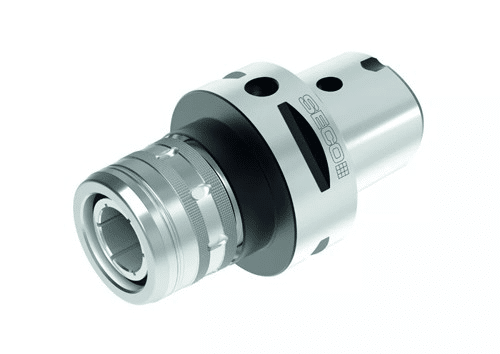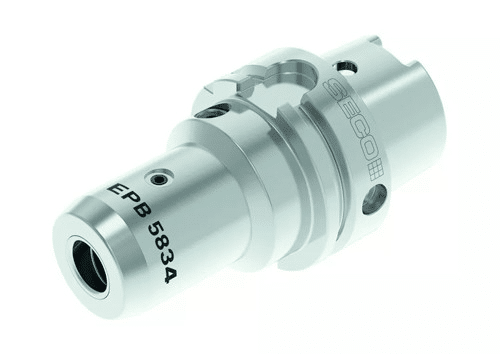High precision CNC lathe paired with advanced cutting tool provides us with superior material removal rate and productivity. As the connector between lathe and cutting tools, tool handle plays an important role in obtaining desired results. So how to choose suitable tool handle with the purpose of best maintenance and ease of use?

Depends on workpiece
The premier factor to influence the choice of collect is machined workpiece’s workability and ultimate status, which can determine a tool handle in the most rational size to help cutter tip reach up to the correct position that whole machining demands. The handle should be as simple and easy to use as possible to minimize the possibility of operator error.
The basic components of the machine tool play a key role – the fast machine tool with linear guide rail will make full use of the tool handle specially designed for high-speed application, while the machine tool with box groove will provide support for heavy-duty machining. Multi task machine tool can complete turning and milling / drilling processes at the same time.
The tool holder can also be selected according to the machining strategy. For example, in order to maximize productivity in high speed cutting (HSC) processes or in high performance cutting (HPC) applications, different cutting tools will be selected in the workshop. The former involves shallower cutting depth HHS, while the latter focuses on producing higher metal removal rates on machines with sufficient power but limited speed.
Low repeatable radial runout helps to ensure constant tool engagement, thereby reducing vibration and maximizing tool life. Balance is very important. The high-quality tool handle should reach precise dynamic balance at g2,5-25000 RPM (1 g.mm). According to the actual situation, or consulting the tool supplier, the machining workshop can determine the tool handle system that can meet its production needs in an economic and efficient way.
Each handle has its own market segment
Whether it is simple side fixed type, jacket type, heat shrinkable type, mechanical type or hydraulic type, the tool handle shall meet the specific process requirements.
Spring collets and interchangeable jackets
It is the most commonly used round handle technology. The economic and efficient Er type provides various sizes and enough clamping force to realize reliable light milling and drilling processes. The high-precision Er jacketed shank has low radial runout (at the tip < 5 μ m) and can be balanced for symmetrical design in high-speed processes, while the reinforced type can be used for heavy-duty machining. Er handle is convenient for fast conversion and can be used for various tool diameters.
Thermal expansion handle
It can provide strong clamping force, 3 μ m concentricity at 3 XD and excellent dynamic balance quality. The small handle design can well reach the difficult part features.

Enhanced handle
Medium to heavy duty milling is possible, but the clamping force depends on the inside diameter tolerance of the shank and shank. A special heating device is required for the expansion tool, and the heating / cooling process requires more installation time than simply switching the jacket.
Mechanical milling collet
It provides strong clamping force and high radial rigidity through multi row needle roller bearings. The design can realize heavy load milling and rapid tool change, but the runout may be larger than the jacket system. The size of the mechanical collet is usually larger than other shank types, which may limit the tool’s access to certain part features.

Compared with the mechanical chuck, the hydraulic chuck which uses the oil pressure to produce the clamping force has fewer internal components, so its shape is relatively thinner. The hydraulic chuck has a low radial run out, which can effectively ream, drill and light mill at high spindle speed, but it is sensitive to large radial load.
The spindle or tapered end determines the torque transmission capacity and tool centering accuracy
Just as important as how the tool holder fixes the cutting tool is how to install the tool holder on the machine spindle. Traditional BT, DIN and cat tool shanks are suitable for smaller machine tools, but may be limited in high-speed machining. Models that are in contact with both the taper and the end face of the shank provide higher rigidity and accuracy, especially in the case of large overhang. Reliable transmission of greater torque requires greater taper size. For example, hsk-e32 tool shank cannot replace hsk-a125a in heavy-duty machining.
The selection of the taper form of the shank usually varies by region. In the mid-1990s, 5-axis machine tools became more and more popular, during which HSK began to emerge in Germany. Cat shank is mainly used in the United States, while in Asia, BT shank is very popular, and it is often the model with double-sided cone / end contact.
HSK is commonly used in 5-axis machining. PSC (polygon clamping system: capto) and KM are mainly used for multi task machine tools, adopting ISO standard. Km and capto are modular systems that allow the assembly of a specific length of tool by combining the extension bar or the reducing bar. With the increasing popularity of multi task machine tools, it is more and more popular to realize turning, milling, drilling and other machining types in one-time clamping.

summary
The workshop must pay attention to the importance of tool holder in the machining system, and know how to match the correct tool holder with the specific machine tool, machining strategy and workpiece to improve productivity and reduce costs.
Future technological improvements will no longer be limited to the handle itself. Tool management using software and RFID tags is a key element of data-based manufacturing and is becoming more and more common. Advances in tool holder technology include a sensor equipped tool holder that can monitor the force on the handle in real time. The collected data allows the operator to adjust the processing parameters during the processing, even through the artificial intelligence (AI) connected with the machine control unit. These technologies and other new technologies will further increase the production contribution value of the tool shank in the processing process.

